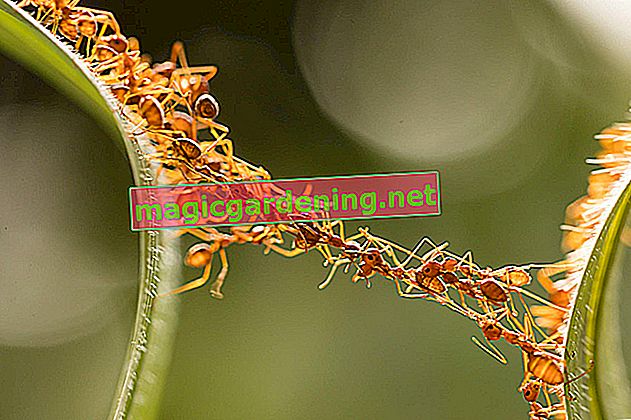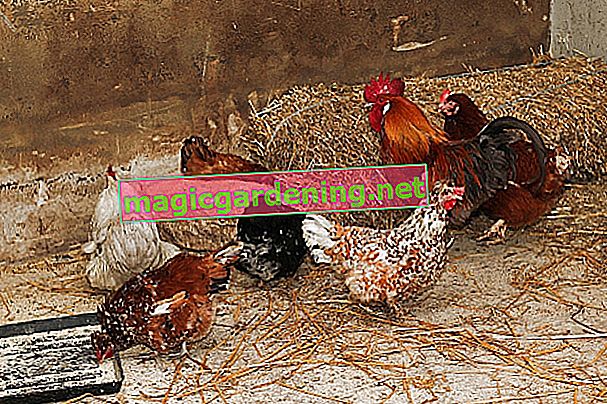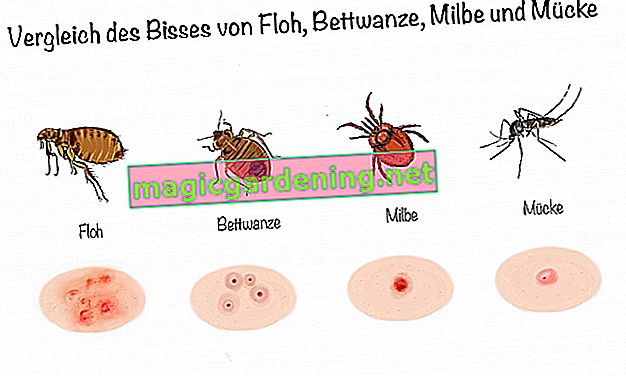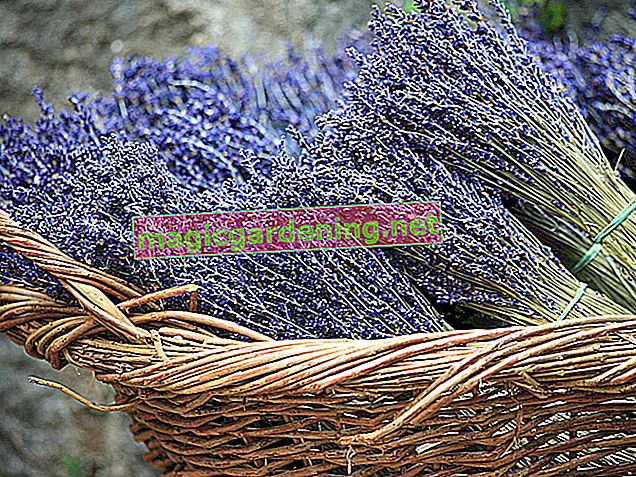
The best home remedies for fleas
"Anyone who goes to bed with dogs gets up with fleas." (Saying)
also read
- Fleas in the garden - this is how you defend yourself against the plague
- The best home remedies for lice - tips about people, plants and animals
- Home remedies for wasps
There are many sprays, shampoos and other flea control agents in specialist shops, but you don't always want to go with the chemical club. Grandma's old home remedies are sometimes no less effective, but at the same time much gentler - not for the fleas, but for humans and their pets. When using it, please note that a one-off measure will unfortunately not lead to the desired success. Fleas that continue to reproduce could still survive - a female flea lays up to 50 eggs a day! - and don't let the problem get any smaller. However, with this procedure you will definitely get rid of these annoying animals:
- Spray the body and fur once a day while dripping wet
- do this for at least ten days
- at the same time clean and wipe the apartment thoroughly every day
- Change bed linen every two days and wash at a minimum of 60 ° C
- Cuddly toys Pack in a plastic bag in the freezer - or wash at at least 60 ° C
- Wash cat or dog beds weekly at 60 ° C
With pets and people

Two types of fleas are quite common in Germany. Cat and dog fleas, however, are not tied to their respective main hosts, but also look for other hosts if there is a lack of food. Cat fleas, in particular, like to pass on to humans, so that pet owners know the problem first-hand. A multitude of recipes for old home remedies for these pests have been handed down, with each family probably swearing by its own mixture. However, most of the mixtures have one striking thing in common: rosemary and lemon are found in almost all homemade anti-flea sprays. This is not surprising, because the strong essential oils of these plants are not particularly popular with the little bloodsuckers.
Rosemary and lemon
A tried and tested recipe for a spray against fleas is something like this:
- Fill a liter of water into a saucepan and boil it up.
- Chop a lemon with the peel and throw it into the boiling water.
- There is also a handful of fresh rosemary needles.
- If there is no fresh one, dried rosemary will also help - provided it has an intense smell.
- Let the mixture simmer for about 15 minutes and then cool for at least two hours.
- Strain the coarse ingredients from the brew.
- Add a few drops of geranium or tea tree oil.
- Pour the mixture into a spray bottle (such as is used to spray house plants or ironing clothes)
- Treat yourself and / or your pet with it.
Let the brew act for about 20 minutes and only then rinse it out again.

Vinegar and lemon
A suitable spray can also be made from normal household vinegar and lemon, with which you can treat not only living things, but also furniture, clothing, carpets, etc. Mix to do this
- 750 milliliters of water
- with 1.5 liters of household vinegar
- and 150 milliliters of freshly squeezed lemon juice
directly in the spray bottle.
Essential oils
In addition to the recipes mentioned, which have been known for a long time with and in this or other form, home remedy mixtures based on various essential oils come from other countries. In the fight against fleas, for example:
- Tea tree oil
- Geranium oil
- Lemon oil / citronella oil
- Eucalyptus oil
You can use these oils alone - about 25 drops on a quarter liter of water - or as a mixture. The main advantage of an oil mixture is that it simultaneously restricts the movement and breathing of the fleas and thus kills them safely. The following mixture, for example, is fragrant for your own nose and is still extremely unpopular with fleas:
- 10 drops of tea tree oil
- 10 drops of eucalyptus oil
- 10 drops of lemon oil
- 1 splash of detergent
Mix thoroughly with 250 milliliters of water and apply.
Kieselguhr
However, diatomite works best by far. This agent consists of the finely ground shells of fossil diatoms, which is why it is also known as diatomaceous earth or mountain meal. Pour the powder into an atomizer and use it to dust your dog / cat, their bedstead, carpets and upholstery. But be careful: The fine dust can irritate the respiratory tract and mucous membranes, which is why the eyes, mouth and nose - including your four-legged protégé - must be protected during use. Leave the powder on for at least 20 minutes and then rinse it off thoroughly or vacuum it off.
Digression
Chickens and other poultry are also affected

By the way, fleas are not only found on dogs and cats, but basically on all furry creatures: rabbits, guinea pigs and other domestic animals can also suffer from this problem. Furthermore, fleas are a common problem, especially with chickens and pigeons, which is why experienced poultry farmers thoroughly clean the poultry houses and then sprinkle them with kieselguhr.
Fighting fleas - hygiene is important!
However, it does not help to get rid of the fleas only with home remedies. Most fleas do not stay on the object of their desire most of the time, but instead hide in the vicinity. Cracks and hollows, but also carpets, curtains, bed linen, mattresses, upholstered furniture and clothing are very popular hiding places. So make sure you include all of these things in your cleansing by using
- clean thoroughly every day
- vacuum and wipe with a damp cloth
- Then immediately dispose of the vacuum cleaner bag outside in the garbage cans
- If possible, wash fabrics in the machine at 60 ° C
- Treat fabrics (such as the sofa, the bed mattress ...) with a self-made anti-flea spray
Hygiene is particularly important in the fight against fleas, because these animals survive best in a less hygienic environment.
Digression
Rat fleas were once responsible for plague epidemics
You have certainly heard of the serious plague epidemics of the Middle Ages and modern times, which regularly wiped out large parts of the population. Even today there are outbreaks in particularly poor parts of this world, in which - then as now - mainly rat fleas act as carriers of this terrible and deathly disease within a very short time. In general, fleas can transmit a whole range of infectious diseases, which, however, only rarely happens in today's hygienic conditions.How do you even recognize a flea infestation?

If you suspect that you or your pet has been infected by a flea, acting quickly is important. The animals reproduce rapidly, so hesitation only makes things worse. In this section, we will therefore tell you how you can reliably identify an infestation.
Typical signs of a flea infestation
If you and / or your pet develop these symptoms, you should act quickly. These signs clearly indicate a flea infestation:
- frequent itching and scratching
- recognizable flea bites (see table)
- Droppings
- sometimes larvae
- rarely live fleas
The animals are difficult to catch alive, after all they hide most of the day and are also extremely nimble. The following article explains how you can identify them based on their droppings:
YoutubeDifferentiate between flea bites and insect bites
If it itches and itches, it doesn't have to be a flea bite. In fact, there are some species in the insect kingdom that leave bites or stings that are quite similar to fleas. The bite marks of bed bugs or mites in particular are very similar to those of fleas, so that no precise distinction can be made based on the marks alone. In addition to the distinctions listed in the table below, you should pay particular attention to these notes:
- Fleas : also bite during the day, often several times, bite marks are generally possible all over the body, otherwise they hide in carpets, upholstered furniture, curtains etc.
- Bed bugs : only bite at night, bite marks only on uncovered parts of the body, like to hide in cracks, carpets, upholstered furniture, etc. during the day.

| Fleas | Bed bugs | Mites | Mosquitoes | |
|---|---|---|---|---|
| Appearance | often several bites in close proximity to each other | often several bites in close proximity to each other | red swelling like an insect bite | usually only a single, slightly reddened or whitish swelling |
| Characteristics | slightly reddened or swollen | slightly reddened or swollen | sometimes with burrows under the skin (scabies / scabies) | swelling about two to five centimeters, no blood spot in the center |
| itching | severe itching, often at all bite sites at the same time | Itching occurs later and can last for several days | severe itching, absolutely in need of medical treatment! | Itching often occurs immediately, severe irritation that can last for several days |
frequently asked Questions
At what temperature do fleas die?
Fleas feel most comfortable at temperatures between 25 and 30 ° C, but are still active at cooler or warmer degrees. You can only kill them safely at at least 60 ° C in the washing machine or minus 18 ° C in the freezer. Here you pack all non-washable textiles and simply freeze them for several days in the event of a flea infestation.
How long can a flea survive?
That a flea can only survive for a very short time without a meal of blood clearly belongs to the realm of fairy tales. On the contrary: The animals can survive for up to a year without food, which is why they can be infested without any pet. This is the case, for example, if you take over an apartment from a previous tenant or previous owner who has a pet. If their animals have had fleas, they can survive unnoticed in cracks and corners.
How old does a flea get?
Fleas don't get old: it takes around one and a half years from egg to adult, with the adult flea only lasting around five to six weeks.
Tips
Since prevention is always better than fighting, your pets should - especially if they are outdoors! - always wear a flea collar.









